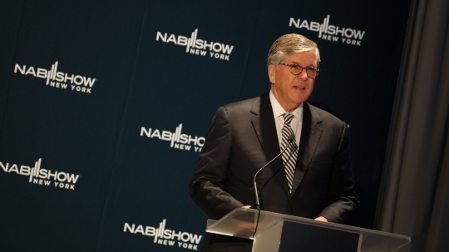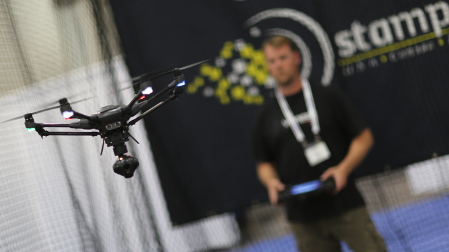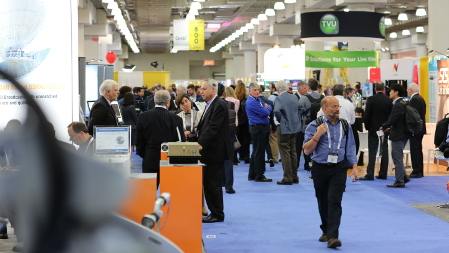NAB Show NY Explores Emerging Technologies
NEW YORK—In its inaugural year, the 2016 NAB Show New York brought 362 exhibitors as well as a record attendance of 15,404, to the Jacob Javits Center. The show, which had previously been known as “Content and Creation World” (CCW), was held in conjunction with infoComm Connections and Satcon.

NAB President/CEO Gordon Smith
NAB President/CEO Gordon Smith highlighted the themes of this year’s show in his opening keynote, noting advances in such areas as drones, IP, AV tech, broadcast-OTT synergies and the transition to ATSC 3.0.
Those areas of drones in production as well as new realities in broadcast and streaming content delivery took center stage in any number of the core session presentations.
BIG SPORTS, BIG EVENTS
Oriana Schwindt, TV News Editor of Variety, moderated a panel entitled “Big Sports, Big Events, The Most Exciting Live TV.” Panelists included Gary Zenkel, president NBC Olympics, Brian Rolapp of NFL Media, and Ray Warren, President NBC Universal-Telemundo.

(L to R) Oriana Schwindt, Variety, Ray Warren, Telemundo Enterprises, Brian Rolapp, National Football League and Gary Zenkel, NBC Sports Group
The professional video industry's #1 source for news, trends and product and tech information. Sign up below.
Zenkel noted that NBC has rights to all Olympic Games through 2032, most recently having completed the Rio Olympics. He quipped that the most popular pre-Olympic activity is focusing on everything that could go wrong; and this Olympics had more than its share of controversies. Yet the narrative shifted the moment the athletes began to march into the stadium for the opening night ceremony.
The Olympic franchise continues to be among TV’s strongest franchises with steady climb in viewership. But as viewing patterns shift from strictly broadcast TV to a combination of web, plus broadcast, constant changes in coverage is inevitable. Likewise, moving more reporting from the venue feels far more immediate to the viewer than a disconnected feeling with production strictly within NBC’s large Stamford, Conn., installation. The challenges of combining live broadcast with delayed broadcast with web coverage help evolve coverage of the games to meet the needs of audiences and leverage ever-emerging technologies.
The NFL faces a different set of challenges according to Brian Rolapp. During the season, professional football is broadcast almost half the week. The most recent expansion is into the Thursday night package which started with just eight games and now has expanded to 12-13 games. The NFL also played three games in London this year and one still to be played in Mexico City in an effort to expand the reach of American pro football and build a world-wide audience. Still, consumption is down this year by some 14 percent, which can be attributed in part to greater viewer attention paid to the elections or perhaps weaker team match-ups on Thursday night. Still, over a three-year period, consumption has risen some 27 percent and international viewership has risen 15 percent.
Ray Warren addressed one of NBC Universal–Telemundo’s most significant large scale broadcast, the FIFA World Cup. The 2018 FIFA World Cup will be held in Russia, which, like the Sochi Olympics, presents a special set of logistic challenges. FIFA itself is described by Warren as “FIFA 2.0,” remaking itself after the scandals of the past several years.
The growth potential of soccer broadcast is immense, driven by women’s soccer as well as by a target young Hispanic audience.
It is in coverage of FIFA that we see the greatest convergence of broadcast and web technologies. And it is most important to understand, in this instance as well as in general terms, that web and broadcast are complimentary and not contradictory. Audiences will use and view media differently. Audiences demand the immediacy of the stream as well as broadcast.
In fact, all three of the panelists agree that web partnerships are critical to the expansion and evolution of broadcast markets and big event production. NFL’s partnership with Twitter and the thousands of hours of Olympic streaming emphasize the audiences’ need for content. And broadcasters today must be audience-driven, which in turn drives delivery modalities.
THE IMPACT OF FACEBOOK LIVE ON BROADCAST
Broadcasters’ need to adapt to new viewing habits was driven home by Bob Gruters, U.S. Group Lead, Tech/Telco, Entertainment, Restaurants, and Multicultural for Facebook. Facebook Live enables any Facebook user to stream video, effectively making anyone a content creator but also completely redefining viewing patterns— “primetime” is now any time and the content is there whenever you want it. The world now is connected by storytellers who are any person with a story to share and an audience to watch. In 2003, five billion gigabytes of on-line content was created, today, that same amount of content is created in 10 minutes. Anyone can stream VR or AR content and Cisco estimates that 75 percent of all mobile data will be video by as early as 2020.

Bob Gruters
Gruters also cautioned creators of what he calls a “paradox of choice.” There are just too many choices out there and we continually develop ways of helping viewers find that content. That’s made even more difficult in today’s world where multitasking on multiple devices such as broadcast TV and mobile device simultaneously effectively can give us a 32-hour day. A corollary component here is finding ways not just to help viewers locate content but to deliver pre-emptively content based upon that user’s viewing patterns.
Finally, he notes, all marketing is digital. Facebook estimates that 60 percent of users regularly employ two digital devices and some 25 percent, three or more devices. Tool kits need to evolve. But the key in this digital world, and something that broadcasters need to take to heart to survive in that world, is that there is no “right way” to do things any more. The path to consumption lies not in how it was done or how to do it right but rather in doing what works. Again, the question is not TV vs. mobile but TV plus mobile. They are different yet they work together.
THE CREATIVE OPPORTUNITY OF DRONES
And what greater difference is there in today’s production environment than the creative opportunities opened by drones. Michael Chambliss, technologist for the International Cinematographers Guild, brought together experienced drone production producers to illustrate several test cases.

But first, all involved in any scale of drone production emphasized the importance of hiring an experienced drone crew. With FCC’s latest Part 107 guidelines, there are clear paths to commercial drone operations but using a crew who does this work and only this work assures efficiency, compliance, safety and quality production.
An example was the last “Good Morning American Country Music Awards” coverage in Nashville. This large-scale on-location production combined a traditionally fixed camera with steadicam with remote cameras and with a number of drone shots. Initially, producers had a pre-conceived plan for the drone coverage; the drone production company, however, prevailed on the producers to just “give us a few minutes to try it our way.” Producers were open to the possibility and were convinced that the drone crew was pretty impressive in their concept.
The drone crew itself consisted of a single pilot, one camera operator and two spotters, essential for safety concerns. The pilot and only the pilot was in touch with the director via headset and he then could convey that direction to the camera operator, guided by the spotters. So, another new challenge: Director now adds drone crew to the mix of crew to direct. Drones find their way into everything from local news to high production value programs to advertising. They are a significant adjunct to conventional terrestrial cameras and even cranes.
Of course, ATSC 3.0 looms over the broadcast industry. The transition to ATSC 3.0 converges with the web-based content delivery that all previous speakers had highlighted. And while we’re looking at challenges for both the immediate as well as long-term future of broadcast, costs and other transition aspects to ATSC 3.0 need to be addressed by broadcasters. The production pipeline has the capability of delivering UHD wide color-gamut signals. UHD consumer sets are coming down in price and even YouTube now accepts HDR video. The time to plan this transition is now.
THE EXHIBIT FLOOR
Of course, it wouldn’t be an NAB Show without product. NAB acquired this show from CCW some three years ago and part of that rebranding was an effort to attract more exhibitors and draw from a potentially wider attendee base. Both seem to have worked this year. Nonetheless, with all of the other fall shows such as IBC being more established worldwide, new product introductions were slim.

Sony announced its new FS7 II camcorder, an advanced model of its FS7 which will remain in the product line. The FS7 II offers electronic variable ND filtration, a locking lens mount and improved ergonomics. In the light of the transition to HDR TV and with an eye to the ATSC 3.0 standard for delivering this content, the FS7 II now can output in BT.2020 color space.
JVC introduced a streaming service entitled Videocloud, a streaming service with plans for small users for $50 per month all the way to enterprise users. And they also introduced three new multiformat LCD monitors suitable for studio or production truck. Most impressive for broadcasters is their ProHD Wireless Bridge Live IP uplink solution. It is possible to stream from a compatible JVC camera to the Live IP device mounted, say, to a car’s rooftop. It consists of a receiver to capture the IP signal and then a bonded cellular transmitter with four antennas to send the signal. Because the encoding is done in camera, the entire IP device system can be bought in the $5,000 price range.
For-A was showing its Thunderbolt-connected switcher paired with graphics systems developed by its technology partner ClassX to create complex yet easily-created graphics in coordination with the power switching capabilities of the Thunderbolt device.
NAB New York 2017 is scheduled for Oct. 18-19 at the Javits Center.
